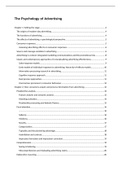Samenvatting
Samenvatting The Psychology of Advertising, ISBN: 9780367346393 Marketing 2 (E_BK2_MKT2)
- Instelling
- Vrije Universiteit Amsterdam (VU)
Samenvatting van de nieuwste editie (3e) van het boek The Pyschology of Advertising. Hoofstuk 1 tot en met hoofdstuk 6. Alles wat je moet kennen voor het vak Marketing II.
[Meer zien]





